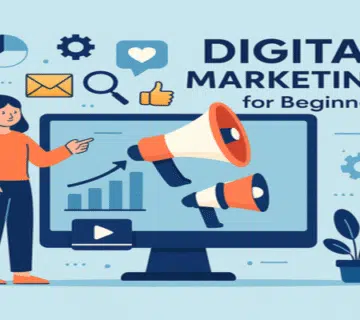Social Media Marketing
Introduction to Social Media Marketing
Social media marketing has become a fundamental component in modern business strategies. It refers to the use of platforms such as Facebook, Instagram, Twitter, and LinkedIn to enhance communication between companies and their customers.
This approach is not limited to promoting products and services but also includes building long-term relationships with the target audience. As a result, social media marketing has become a crucial necessity for achieving market success.
Social media has transformed the way companies interact with their clients by providing a platform that allows easy and accessible engagement.
This shift in communication fosters transparency and trust, increasing customer loyalty. Through social media channels, brands can engage directly with audiences and receive immediate feedback—one of the key advantages of this type of marketing.

Additionally, social media enables businesses to reach a much wider audience than previously possible. Through targeted campaigns and dynamic advertising, brands can fine-tune their strategies to reach the right segment of consumers. Core benefits of using social media channels include increased brand awareness, improved digital presence, and higher revenue through effective marketing campaigns.
In today’s business landscape, companies cannot ignore the importance of social media marketing, as it serves as a key to effective communication and achieving strategic marketing objectives.
The Importance of Targeting the Right Audience
Targeting the right audience is a cornerstone of successful social media marketing strategies. This requires the use of analytical tools to precisely identify target segments. Marketing campaigns are more effective when they are based on a deep understanding of audience needs and preferences. Effective content marketing depends on finding the right voice that resonates with the target audience, with the first step being the development of a strong brand persona.
A well-defined brand persona highlights the unique characteristics of a company or product, facilitating communication with the intended audience. It includes attributes such as age, gender, geographic location, and interests. With this understanding, marketers can make informed decisions about the type of content to produce, the best times to post, and which platforms to use for outreach.
Moreover, social media platforms provide detailed insights and analytics. These include data on how users interact with content, which helps in understanding behavioral patterns and tailoring campaigns accordingly. For instance, analyzing when users are most responsive to content can significantly impact campaign effectiveness. Content posted at the right time is more likely to receive greater engagement, including shares, likes, and comments.
Deep audience insight enhances campaign effectiveness, driving positive results in engagement and sales. Clearly, targeting the right audience requires dedication and creativity, but it is also a vital step in boosting a brand’s competitive edge in a crowded marketplace.
Setting Marketing Goals
Setting marketing goals is essential for any successful social media campaign. Clear and specific goals provide direction for achieving measurable results and evaluating performance. Marketing objectives vary depending on the campaign, but they often include increasing brand awareness, boosting engagement, and driving sales.
To begin, determine what you want to achieve through social media. For example, if the goal is to raise brand awareness, the strategy should focus on reaching a broader audience and ensuring they become familiar with the products or services. This can be measured through key performance indicators (KPIs) such as new followers, views, and shares. Social media analytics tools can be used to track changes in reach.
If the goal is to improve engagement, the focus should be on interaction metrics—likes, comments, and content shares. Social media marketers must create compelling content that encourages users to interact and participate. Brands can also use polls or contests to increase engagement opportunities.
For driving sales, clear strategies must be developed, such as using paid ads to generate direct sales. Results can be measured through KPIs like the percentage of sales attributed to social media campaigns. Following these strategies is crucial for the success of marketing efforts and achieving desired outcomes.
Creating Attractive and Valuable Content
Creating engaging and valuable content is a core component of social media marketing strategies. It requires thoughtful planning about the type of content that will attract and retain the attention of the target audience. Content formats vary from text, images, and videos to blog articles. Each has its advantages and drawbacks, but the main objective is to deliver added value to users.
Images and videos play a significant role in delivering messages more effectively than text alone. These media types enhance the user experience and make the content more appealing. For example, videos can be used to showcase products or services in an engaging and easy-to-understand way. Visual content is also highly shareable, helping increase brand awareness. Meanwhile, blogs offer an opportunity to provide in-depth information and detailed analysis on specific topics, fostering trust between the brand and its audience.
Additionally, it’s important to consider how to deliver value through content. This could include offering useful information, practical guidance, or even entertaining material. Users should feel they gain something valuable when interacting with the content. This helps marketers strengthen relationships, build loyalty, and achieve long-term results.
In this context, analyzing data and evaluating content performance is essential. Understanding what audiences prefer and respond to allows for continuous improvement and the creation of content that meets user needs and expectations.
Paid Advertising Strategies
Paid advertising strategies on social media are rapidly evolving, becoming essential for efficiently reaching target audiences at reasonable costs. These strategies rely on using paid ads to ensure brand content is seen by the right recipients, increasing awareness and boosting sales.
One key element in paid advertising is targeting. Platforms like Facebook and Instagram allow advertisers to customize campaigns based on various factors, such as age, location, interests, and past behaviors. This capability to reach specific consumer segments enhances the likelihood of positive results. For example, companies targeting younger audiences can use engagement techniques that resonate with their preferences, increasing interest in their products.
Paid ads come in several formats, including story ads, image ads, and interactive ads. Each offers unique ways to capture attention and deliver messages creatively. Choosing the right format is critical to achieving goals—whether driving traffic to a website or generating leads.
To maximize return on investment (ROI), advertisers should regularly review and analyze ad performance. Ongoing data analysis enables informed decisions on campaign optimization and budget allocation. Methods such as A/B testing help identify the most effective ad elements.
Influencer Marketing
Influencer marketing has emerged as a powerful tool in social media marketing, helping strengthen brands and increase audience awareness. Selecting the right influencers is crucial to campaign success. Influencers must align with the brand’s values and industry to ensure effective outreach to the target audience.
To start, businesses should consider key factors when choosing influencers, such as follower count, engagement rate, and content relevance. Influencers should match the target market, enhancing message credibility. Reviewing the quality of content and audience interaction also indicates the potential reach and effectiveness of the campaign.
Once suitable influencers are selected, the next step is building effective partnerships. This involves direct communication and aligning on shared goals and vision. It’s essential to clarify mutual benefits for both the brand and the influencer to ensure a successful collaboration. Moreover, marketing campaigns should feel authentic and non-intrusive, strengthening trust between the brand and the audience.
Creativity is key in crafting joint promotional activities. Customized content that demonstrates product or service use directly through influencers helps create a realistic connection between brands and consumers, facilitating effective persuasion.
Data Analysis and Performance Measurement
Data analysis and performance measurement are vital in social media marketing. In a competitive landscape, leveraging data from campaigns is necessary to understand effectiveness and make informed decisions. Analytical tools allow campaign managers to track various metrics such as follower count, engagement, and content sharing, providing a comprehensive view of content performance.
Popular data analysis tools include Google Analytics, Facebook Insights, and Hootsuite. Each offers unique features for gathering and analyzing data effectively. For instance, Google Analytics can measure website traffic driven by campaigns, while Facebook Insights provides detailed follower behavior on a brand’s page. These tools help businesses evaluate campaign results from different angles, offering deeper understanding of the target audience and their preferences.
When using these tools, focus should be placed on core metrics such as click-through rate, conversion rate, and average time on page. Analyzing these metrics helps marketing teams identify campaign strengths and weaknesses. If unexpected results arise, strategies can be adjusted to better meet audience needs. Therefore, data analysis is an integral part of any social media marketing strategy, enhancing performance and achieving set objectives more effectively.
Emerging Trends in Social Media Marketing
Social media marketing is a constantly evolving field, with emerging trends reshaping how brands communicate and interact with their audiences. One of the most prominent trends is the use of artificial intelligence (AI), which provides detailed insights into user behaviors and interests, allowing companies to personalize their campaigns more effectively. AI also enhances the customer experience through chatbots that offer instant support and help with decision-making.
Additionally, content marketing is gaining importance. The idea revolves around producing engaging and valuable content that resonates with the target audience, fostering stronger brand-consumer relationships. Brands that adopt content-driven strategies can strengthen their digital presence and build customer loyalty. However, content must be creative and accurately reflect the brand’s vision to deliver meaningful results.
User-generated content is also growing in influence. This type of content is seen as more credible and can deeply impact purchasing decisions. When customers share their experiences and opinions about products or services on social media, it builds trust and expands reach to wider audiences. Thus, involving users in marketing campaigns is vital for increasing organic promotion and building brand communities.
Overall, modern trends in social media marketing involve integrating advanced technologies with effective content strategies, reshaping how brands engage with their audiences.
Conclusion: The Future of Social Media Marketing
Social media marketing remains a fundamental part of modern marketing strategies, and its growing importance in business is undeniable. The field is rapidly evolving, requiring companies to keep pace with changes and new trends to ensure sustained success. Social media offers businesses a unique opportunity to reach their target audiences innovatively and efficiently, without the budget constraints often associated with traditional marketing.
In the future, advanced technologies like artificial intelligence and data analytics are expected to play an even greater role in shaping social media marketing approaches. These tools will allow companies to better personalize content and understand audience needs, enhancing engagement and authenticity. Brands should also leverage video and visual content, as these formats have become increasingly appealing to users.
To succeed in this dynamic field, companies must focus on building genuine relationships with customers, converting followers into loyal clients. Adopting a transparent and authentic approach is essential, as users prefer brands that communicate honestly. Moreover, implementing continuous analytics to review performance and refine strategies will help improve outcomes and boost competitiveness on social platforms.
Given these trends and developments, social media represents a powerful tool for enhancing marketing effectiveness. Companies should strive to harness its potential to grow and innovate in the digital age.








Such a powerful topic! Managing social media effectively is key to building a strong, authentic brand presence.
Such a smart angle! When done right, direct marketing builds trust and drives conversions like nothing else.
“A must-have guide for any marketing team — the right toolkit boosts productivity, precision, and performance!